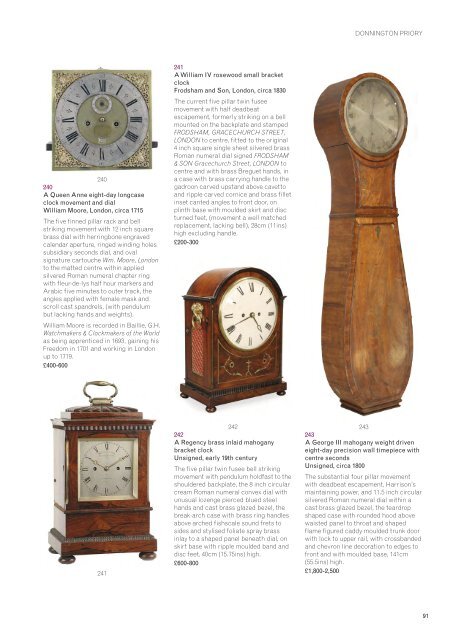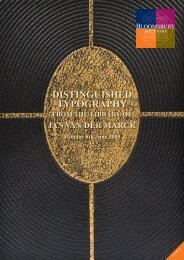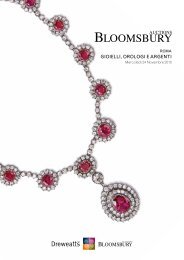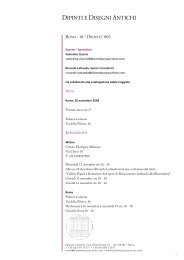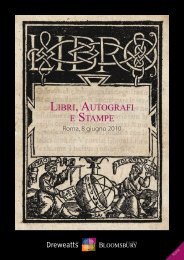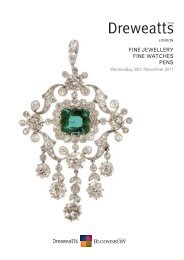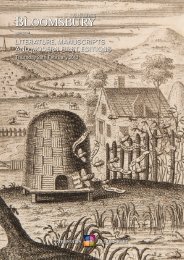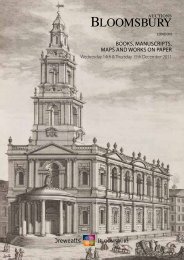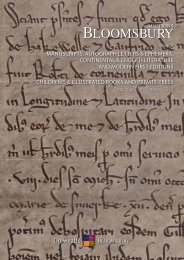PDF Download - Bloomsbury Auctions
PDF Download - Bloomsbury Auctions
PDF Download - Bloomsbury Auctions
You also want an ePaper? Increase the reach of your titles
YUMPU automatically turns print PDFs into web optimized ePapers that Google loves.
240<br />
240<br />
A Queen Anne eight-day longcase<br />
clock movement and dial<br />
William Moore, London, circa 1715<br />
The five finned pillar rack and bell<br />
striking movement with 12 inch square<br />
brass dial with herringbone engraved<br />
calendar aperture, ringed winding holes<br />
subsidiary seconds dial, and oval<br />
signature cartouche Wm. Moore, London<br />
to the matted centre within applied<br />
silvered Roman numeral chapter ring<br />
with fleur-de-lys half hour markers and<br />
Arabic five minutes to outer track, the<br />
angles applied with female mask and<br />
scroll cast spandrels, (with pendulum<br />
but lacking hands and weights).<br />
William Moore is recorded in Baillie, G.H.<br />
Watchmakers & Clockmakers of the World<br />
as being apprenticed in 1693, gaining his<br />
Freedom in 1701 and working in London<br />
up to 1719.<br />
£400-600<br />
241<br />
241<br />
A William IV rosewood small bracket<br />
clock<br />
Frodsham and Son, London, circa 1830<br />
The current five pillar twin fusee<br />
movement with half deadbeat<br />
escapement, formerly striking on a bell<br />
mounted on the backplate and stamped<br />
FRODSHAM, GRACECHURCH STREET,<br />
LONDON to centre, fitted to the original<br />
4 inch square single sheet silvered brass<br />
Roman numeral dial signed FRODSHAM<br />
& SON Gracechurch Street, LONDON to<br />
centre and with brass Breguet hands, in<br />
a case with brass carrying handle to the<br />
gadroon carved upstand above cavetto<br />
and ripple carved cornice and brass fillet<br />
inset canted angles to front door, on<br />
plinth base with moulded skirt and disc<br />
turned feet, (movement a well matched<br />
replacement, lacking bell), 28cm (11ins)<br />
high excluding handle.<br />
£200-300<br />
242<br />
242<br />
A Regency brass inlaid mahogany<br />
bracket clock<br />
Unsigned, early 19th century<br />
The five pillar twin fusee bell striking<br />
movement with pendulum holdfast to the<br />
shouldered backplate, the 8 inch circular<br />
cream Roman numeral convex dial with<br />
unusual lozenge pierced blued steel<br />
hands and cast brass glazed bezel, the<br />
break-arch case with brass ring handles<br />
above arched fishscale sound frets to<br />
sides and stylised foliate spray brass<br />
inlay to a shaped panel beneath dial, on<br />
skirt base with ripple moulded band and<br />
disc feet, 40cm (15.75ins) high.<br />
£600-800<br />
DONNINGTON PRIORY<br />
243<br />
243<br />
A George III mahogany weight driven<br />
eight-day precision wall timepiece with<br />
centre seconds<br />
Unsigned, circa 1800<br />
The substantial four pillar movement<br />
with deadbeat escapement, Harrison’s<br />
maintaining power, and 11.5 inch circular<br />
silvered Roman numeral dial within a<br />
cast brass glazed bezel, the teardrop<br />
shaped case with rounded hood above<br />
waisted panel to throat and shaped<br />
flame figured caddy moulded trunk door<br />
with lock to upper rail, with crossbanded<br />
and chevron line decoration to edges to<br />
front and with moulded base, 141cm<br />
(55.5ins) high.<br />
£1,800-2,500<br />
91


